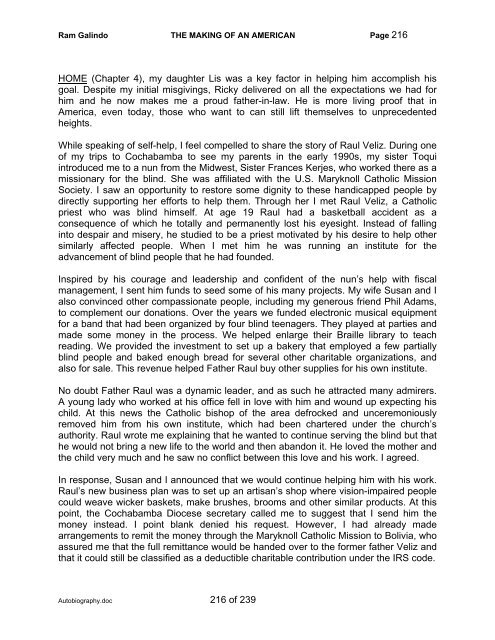Autobiography - The Galindo Group
Autobiography - The Galindo Group
Autobiography - The Galindo Group
You also want an ePaper? Increase the reach of your titles
YUMPU automatically turns print PDFs into web optimized ePapers that Google loves.
Ram <strong>Galindo</strong> THE MAKING OF AN AMERICAN Page 216<br />
HOME (Chapter 4), my daughter Lis was a key factor in helping him accomplish his<br />
goal. Despite my initial misgivings, Ricky delivered on all the expectations we had for<br />
him and he now makes me a proud father-in-law. He is more living proof that in<br />
America, even today, those who want to can still lift themselves to unprecedented<br />
heights.<br />
While speaking of self-help, I feel compelled to share the story of Raul Veliz. During one<br />
of my trips to Cochabamba to see my parents in the early 1990s, my sister Toqui<br />
introduced me to a nun from the Midwest, Sister Frances Kerjes, who worked there as a<br />
missionary for the blind. She was affiliated with the U.S. Maryknoll Catholic Mission<br />
Society. I saw an opportunity to restore some dignity to these handicapped people by<br />
directly supporting her efforts to help them. Through her I met Raul Veliz, a Catholic<br />
priest who was blind himself. At age 19 Raul had a basketball accident as a<br />
consequence of which he totally and permanently lost his eyesight. Instead of falling<br />
into despair and misery, he studied to be a priest motivated by his desire to help other<br />
similarly affected people. When I met him he was running an institute for the<br />
advancement of blind people that he had founded.<br />
Inspired by his courage and leadership and confident of the nun’s help with fiscal<br />
management, I sent him funds to seed some of his many projects. My wife Susan and I<br />
also convinced other compassionate people, including my generous friend Phil Adams,<br />
to complement our donations. Over the years we funded electronic musical equipment<br />
for a band that had been organized by four blind teenagers. <strong>The</strong>y played at parties and<br />
made some money in the process. We helped enlarge their Braille library to teach<br />
reading. We provided the investment to set up a bakery that employed a few partially<br />
blind people and baked enough bread for several other charitable organizations, and<br />
also for sale. This revenue helped Father Raul buy other supplies for his own institute.<br />
No doubt Father Raul was a dynamic leader, and as such he attracted many admirers.<br />
A young lady who worked at his office fell in love with him and wound up expecting his<br />
child. At this news the Catholic bishop of the area defrocked and unceremoniously<br />
removed him from his own institute, which had been chartered under the church’s<br />
authority. Raul wrote me explaining that he wanted to continue serving the blind but that<br />
he would not bring a new life to the world and then abandon it. He loved the mother and<br />
the child very much and he saw no conflict between this love and his work. I agreed.<br />
In response, Susan and I announced that we would continue helping him with his work.<br />
Raul’s new business plan was to set up an artisan’s shop where vision-impaired people<br />
could weave wicker baskets, make brushes, brooms and other similar products. At this<br />
point, the Cochabamba Diocese secretary called me to suggest that I send him the<br />
money instead. I point blank denied his request. However, I had already made<br />
arrangements to remit the money through the Maryknoll Catholic Mission to Bolivia, who<br />
assured me that the full remittance would be handed over to the former father Veliz and<br />
that it could still be classified as a deductible charitable contribution under the IRS code.<br />
<strong>Autobiography</strong>.doc 216 of 239


